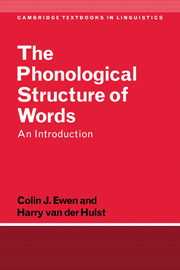2 - Features
Published online by Cambridge University Press: 11 May 2010
Summary
The nature of phonological features
In Chapter 1 we established that the atoms of phonological representation must be smaller than the segments expressed in the notational system of, for example, the IPA, and that these atoms are appropriately modelled by units commonly referred to as phonological features. Each phonological feature is deaned in terms of some phonetic property, so that any phonological feature system makes a claim as to the phonetic properties which can function in the phonological processes of languages. The value associated with a feature for a particular segment shows that that segment either does or does not bear the phonetic property in question. For example, if we assign a segment the feature-values [+low, −round], we are claiming that it belongs to the class of [+low] segments, but not to the class of [+round] segments. Although this may seem trivial, we shall show later in this section that the latter claim is not as straightforward as it may appear. In particular, the corollary of the claim, i.e. that something which does not belong to the class of [+round] segments therefore belongs to the class of [−round] segments, is controversial, and we shall return to this below. However, irrespective of this issue, the tacit assumption we have been making is that there is always a binary choice involved: segments either belong to the set characterised by + or the set characterised by –. On this assumption, segments never have more than two degrees of a particular property, at least from a phonological viewpoint.
- Type
- Chapter
- Information
- The Phonological Structure of WordsAn Introduction, pp. 54 - 114Publisher: Cambridge University PressPrint publication year: 2000



